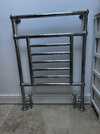Hi,
Thanks in advance for a any advice!
I have a very cold bathroom with (I think) no insulation in the roof and a small chrome towel rail. The towel rail gets hot but does nothing to heat the room. I'm thinking of replacing it with either a larger/better towel rail or a vertical radiator but aren't sure how much of a difference this could make.
Is there a way to do this using the existing towel rail pipework, as the floor is large stone slabs and I assume would make things tricky otherwise?
Cheers!
Thanks in advance for a any advice!
I have a very cold bathroom with (I think) no insulation in the roof and a small chrome towel rail. The towel rail gets hot but does nothing to heat the room. I'm thinking of replacing it with either a larger/better towel rail or a vertical radiator but aren't sure how much of a difference this could make.
Is there a way to do this using the existing towel rail pipework, as the floor is large stone slabs and I assume would make things tricky otherwise?
Cheers!



